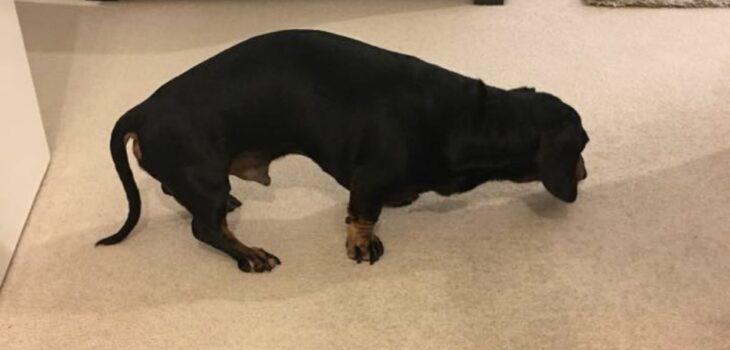The classic dachshund puppy arched back stance can be a worrying sight, as many dog owners fear the worst and suspect that a spinal problem might be to blame. But is a puppy arched back always a serious problem, or could it be due to something more innocent? Let’s find out!
Causes Of Dachshund Puppy Arched Back
If your dachshund puppy suddenly develops an arched back, is this something to worry about? Or is this normal for a dachshund?
Standing with an arched back can be an indication of several different problems in dachshunds. An arched back is the classic sign of a spinal problem called intervertebral disc disease (IVDD).
Unfortunately dachshunds are particular prone to IVDD due to their long spines, and this is a prevalent problem in this popular breed of dog. It is thought that up to a quarter of dachshunds will suffer from IVDD at some point during their lives.
An arched back is not always a sign of IVDD in dachshunds, but it is a strong indication and should not be ignored. Never attempt to force a dog to move that is showing signs of back pain. Even if the dog does not have IVDD, a hunched back could indicate other back problems such as muscular strains.
Some dachshunds will also arch their backs in response to other sources of discomfort such as abdominal pain. Whilst dachshunds are plucky and courageous dogs, they are very sensitive to pain and will stand in a hunched position if they feel uncomfortable.

Signs Of IVDD In Dachshunds
The classic symptom of IVDD in dachshunds is a hunched stance, with the back arched upwards. The dog does this to try and relieve the pain of the prolapsed intervertebral disc. The dog will also be reluctant to move, and may yelp if picked up.
Other signs of IVDD in dachshunds include a reduced appetite and lack of bladder control. Your usually adoring dachshund may become grumpy and aggressive due to the high levels of pain.
Some dogs with IVDD also show neurological symptoms such as incoordination and wobbliness. You may notice the dog swaying as it walks, or observe that it cannot place its feet down on the floor in a coordinated manner. In severe cases of IVDD, the dog may be partially or completely paralyzed and become incontinent.
Diagnosis Of Dachshund Puppy Arched Back
Early investigation of symptoms of pack problems in dachshunds is essential to maximize the chances of a full recovery. There may be an innocent reason why your dachshund is arching its back, but it is always preferable to err on the side of caution and seek veterinary advice.
When transporting a dog with suspected back problems to the veterinary clinic, use a dog crate that prevents the dog from moving around unnecessarily. Drive carefully to avoid sudden movements which may make the injury worse.
If your dachshund puppy yelps when picked up, this can be a clear indication of pain. Your veterinarian will carry out a full physical examination of your dachshund, palpating the back and abdomen and checking neurological reflexes. If your dog is comfortable enough to move, your veterinarian may watch it walking to check for any signs of lameness.

When the cause of back pain is thought to be IVDD, it will be necessary to carry out further diagnostic tests to evaluate the severity of the condition and decide on a treatment plan. Radiographs, also known as X-rays, are used to diagnose IVDD. Other diagnostic imaging techniques such as CT or MRI scans may also be carried out by specialist veterinary hospitals, and can be helpful to investigate the extent of the problem.
Diagnosis Of Dachshund Puppy Arched Back
In mild cases of IVDD in dachshunds, your veterinarian will normally advise a period of rest and restricted exercise for 6 to 8 weeks. During this time the dog will need to be kept in a cage, and once signs of healing are observed a gradual return to controlled exercise can be facilitated. Your veterinarian will also prescribe anti-inflammatory medication to make your dog more comfortable.
Severe cases of IVDD in dachshunds are unlikely to resolve without surgical intervention. Surgery should be carried out within 24 hours of clinical signs developing for the best chance of a full recovery. For this reason, any suspected case of IVDD in dachshunds should be booked in for an emergency veterinary examination as soon as possible.
Not all veterinarians have the experience and facilities to carry out spinal surgery, and your dog may need to be transferred to a specialist hospital. Following surgery, a long period of rest and rehabilitation therapy will be necessary to maximize the chances of a full recovery.
How To Prevent IVDD In Dachshunds
Unfortunately, IVDD in dachshunds is a common problem, and some dogs will develop this condition no matter how carefully you look after them. These little dogs have long spines that are highly prone to intervertebral disc prolapse, but there are some steps we can take to minimize the risk of this problem.
Dachshunds are prone to spinal injures incurred when jumping up and down from high objects. Providing steps to help them access furniture can help to reduce injuries, and they should not be allowed to frequently run up and down stairs. Use stair gates to keep your dachshund on one floor level.
Summary – Dachshund Puppy Arched Back
So, as we have learned, a curved dachshund back is the classic sign of a spinal problem called intervertebral disc disease (IVDD). Unfortunately dachshunds are particular prone to IVDD due to their long spines, and this is a prevalent problem in this popular breed of dog. Some dachshunds will also arch their backs in response to other sources of discomfort such as abdominal pain.
We’d love to hear your thoughts on the causes of dachshund puppy arched back! Do you have concerns that your dachshund puppy might be suffering from back pain? Or perhaps you’ve got some questions about how to prevent back problems in dachshunds? Leave a comment below and we will get back to you!





